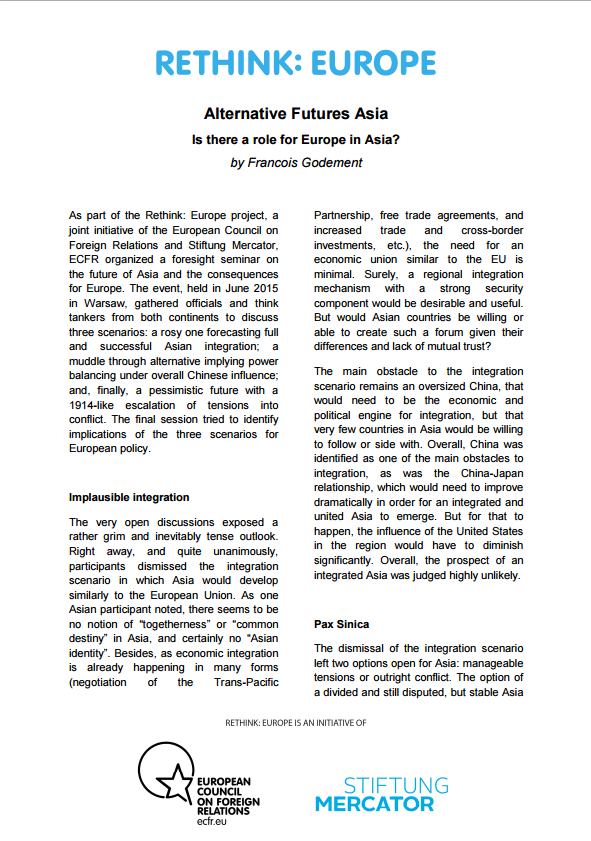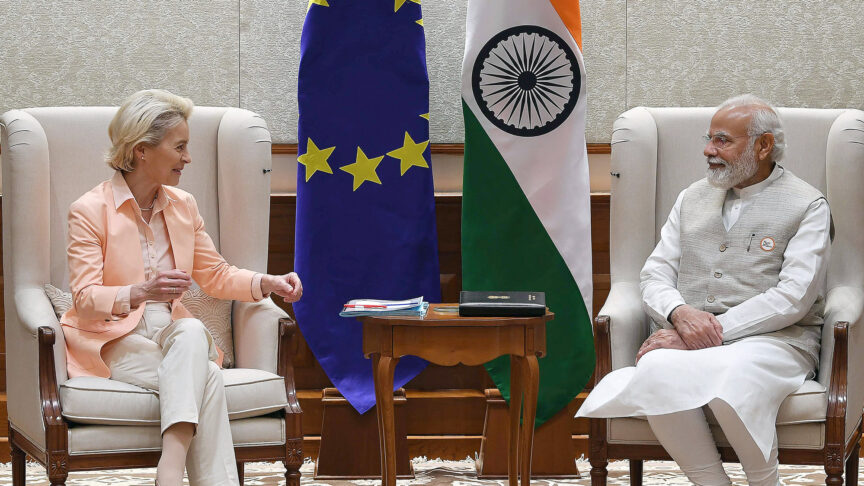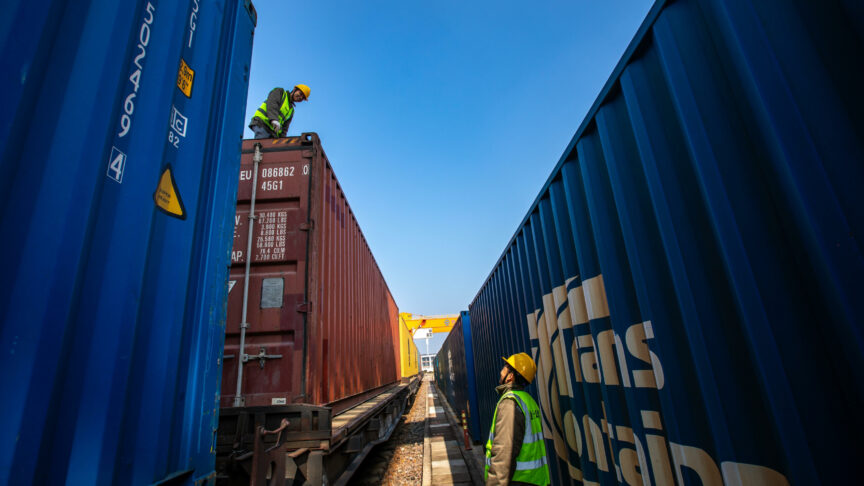Alternative Futures Asia
Is there a role for Europe in Asia?
As part of the Rethink: Europe project, a joint initiative of the European Council on Foreign Relations and Stiftung Mercator, ECFR organized a foresight seminar on the future of Asia and the consequences for Europe. The event, held in June 2015 in Warsaw, gathered officials and think tankers from both continents to discuss three scenarios: a rosy one forecasting full and successful Asian integration; a muddle through alternative implying power balancing under overall Chinese influence; and, finally, a pessimistic future with a 1914-like escalation of tensions into conflict. The final session tried to identify implications of the three scenarios for European policy.
Implausible integration
The very open discussions exposed a rather grim and inevitably tense outlook. Right away, and quite unanimously, participants dismissed the integration scenario in which Asia would develop similarly to the European Union. As one Asian participant noted, there seems to be no notion of “togetherness” or “common destiny” in Asia, and certainly no “Asian identity”. Besides, as economic integration is already happening in many forms (negotiation of the Trans-Pacific Partnership, free trade agreements, and increased trade and cross-border investments, etc.), the need for an economic union similar to the EU is minimal. Surely, a regional integration mechanism with a strong security component would be desirable and useful. But would Asian countries be willing or able to create such a forum given their differences and lack of mutual trust?
The main obstacle to the integration scenario remains an oversized China, that would need to be the economic and political engine for integration, but that very few countries in Asia would be willing to follow or side with. Overall, China was identified as one of the main obstacles to integration, as was the China-Japan relationship, which would need to improve dramatically in order for an integrated and united Asia to emerge. But for that to happen, the influence of the United States in the region would have to diminish significantly. Overall, the prospect of an integrated Asia was judged highly unlikely.
Pax Sinica
The dismissal of the integration scenario left two options open for Asia: manageable tensions or outright conflict. The option of a divided and still disputed, but stable Asia was considered most likely by some, and the “best case scenario” for most. In this future China would be the most dominant Asian country but has learned not to push its power too far. Attempts at balancing China’s oversized power have been abandoned, while China’s ambitions have been contained. Still, this is a configuration where Chinese dominance is accompanied by continued involvement of the United States, and a remaining defiance of a number of Asian countries towards China. Not much unlike today, this situation would see China’s power backed by substantial and readily available cash that other Asian countries find too good to turn down while at the same time looking to the United States to provide security in the region. Hence, this remains a situation dominated by China and the United States, with little role for other regional powers such as India or Japan – and even less so for the European Union.
When, not if
While this fragile equilibrium with Chinese dominance was the preferred and still realistic outcome, participants did see the pessimistic scenario – a full-on 1914-style conflict in the region – as very possible. For some Asian participants it was the most likely future. More so than Europeans, it seemed, Asian participants saw China’s rise as a very tangible threat. It was described as a mix of increased self-confidence, military spending, nationalistic stances, and decreasing economic dependence to the rest of the world, all of which could potentially lead towards conflict. Besides, China today is pushing to test boundaries in Asia – and it is clearly encouraged to continue to do so by the lack of a clear response so far. The possibility of a conflict with China is thus directly linked to the American willingness to intervene in the region in the case of conflict, especially in defence of countries not formally allied with the United States. Direct conflict with America or its allies was judged much less likely – and would remain “capped” to a certain level – while a conflict with other Asian countries was highly plausible, especially with Vietnam. The potential for a limited or full-scale conflict is so realistic that some participants spoke of “when” instead of “if”. One participant even welcomed a clash with China sooner rather than later, believing that for some time still, China would lose.
As Asia’s future remains unknown, the factors that are going to shape it most significantly include future American policy towards China following the 2016 presidential elections, the quality of alliances, including their extension, requirements, and credibility, and, not least, China’s attitude and strategic objectives. Overall, the main question determining the future of Asia is the following: What does China want?
What role for Europe?
The EU’s role, within this configuration, is therefore extremely limited. Nothing in the discussion pointed to a strategic influence for Europe. Its leverage was said to be only on the margins or indirect at best. Within a future mainly shaped by China and the United States, the European Union struggles to find its place, and its voice. As its member states are usually very silent on Asia, the disunity between them on many issues further erodes any political legitimacy for common action in the region. A rather weak European External Action Service amplifies this phenomenon.
In light of all this, two recommendations emerge for the EU’s Asia policy. First, European decision-makers should be much more aware and careful of the economic and security implications of disputes in Asia that are very likely to escalate into an actual conflict, which, as some participants pointed out, is not a question of whether it will happen, but more when and how. Second, Europe’s limited answers – the promotion of the rule of law, confidence-building, transversal and unconventional security, etc. – should not disguise the need for high-level, and above all, coherent and united diplomatic responses, including with a balance in its relations with Asian partners.
Europe’s “cardinal sin” today is its lack of a global and coherent strategy, backed by all its member states. Without it, the EU cannot hope to have influence in Asia. At present, should a conflict arise, it is practically sure that Europe would be at least as divided as it was over Iraq in 2002.
Picture on Rethink Europe page (cc) Trey Ratcliff / Flickr
The European Council on Foreign Relations does not take collective positions. ECFR publications only represent the views of their individual authors.



